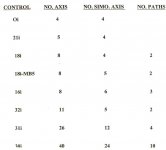Hardplates
Stainless
- Joined
- May 8, 2019
- Location
- What once was a free country
I do mostly 3D milling and surfacing. I'm looking to step up my game and get a machine that can handle lots of little linear moves quickly and smooth them out in the controller rather than having to do it in CAM.
I am far more familiar with older controls from the late 80s and I push a 32 bit Mitsu 320M far harder and faster than people have said I could but the time seems to be right to step into something a little more modern (for me anyway).
It is my understanding that a 16 is superior to an 18 (Fanuc has a wonderful numbering system )I am aware that options can play a big roll also but I don't really know which options to look for.
)I am aware that options can play a big roll also but I don't really know which options to look for.
In my search for an OKK with a Mitsu 600 series I came across one with a Fanuc 21iM. What's the deal with the 21iM? Better than a 16? Worse? Same but newer? Older? Also is a 16 and a 16i different?
As with most things Fanuc it is shrouded in mystery and secrecy. I was hoping someone could help me decipher the hieroglyphs.
Thanks in advance
Paul
I am far more familiar with older controls from the late 80s and I push a 32 bit Mitsu 320M far harder and faster than people have said I could but the time seems to be right to step into something a little more modern (for me anyway).
It is my understanding that a 16 is superior to an 18 (Fanuc has a wonderful numbering system
 )I am aware that options can play a big roll also but I don't really know which options to look for.
)I am aware that options can play a big roll also but I don't really know which options to look for.In my search for an OKK with a Mitsu 600 series I came across one with a Fanuc 21iM. What's the deal with the 21iM? Better than a 16? Worse? Same but newer? Older? Also is a 16 and a 16i different?
As with most things Fanuc it is shrouded in mystery and secrecy. I was hoping someone could help me decipher the hieroglyphs.
Thanks in advance
Paul



